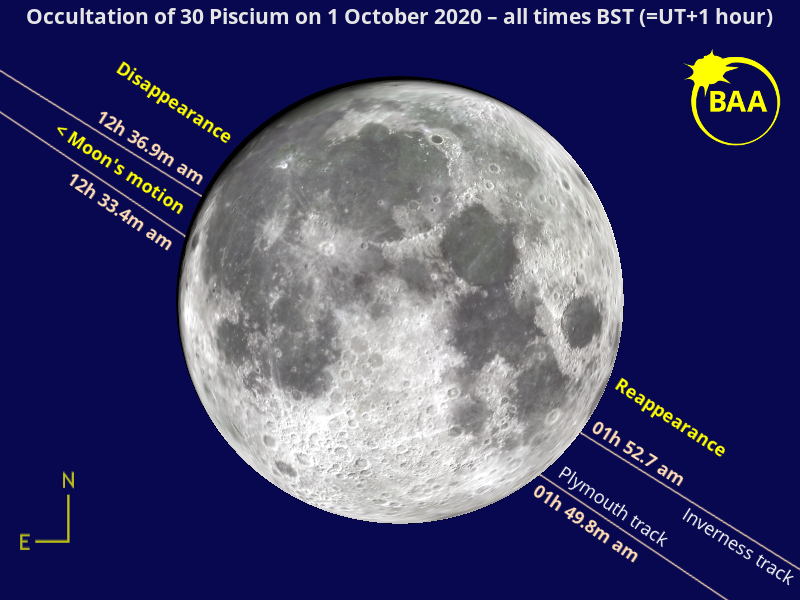2020 September 28
See the 14-day-old Moon occult 30 Piscium on Sept. 30 / Oct. 1

Naked-eye star 30 Piscium, otherwise known as YY Piscium, is a pulsating long-period irregular variable whose magnitude varies from +4.3 to +4.4. It is a red giant around 425 light-years distant with the following J2000.0 equatorial coordinates: α = 00h 01.9m, δ = -06° 01′.
An occultation of 30 Piscium by the almost full Moon straddling the UT dates of September 30/October 1 is visible from the entire British Isles – a property it shares with the recent lunar occultation of Epsilon (ε) Capricorni. As always, the exact time and duration of the star’s disappearance/reappearance depends on where you live in the UK, which is summarised for a widespread list of locations in a table at the bottom of the page. Note: the table uses Universal Time, as is the convention, so don’t forget to add one hour to convert to the corresponding British Summer Time (BST).
Observers in London will see the star disappear at the darkened limb of the 14-day-old Moon shortly after 12:40am BST on October 1 (23:40 UTC on September 30), and reappear at the bright lunar limb almost 74 minutes later. For a skywatcher in Edinburgh, the star’s corresponding disappearance and reappearance times are shortly after 12:37am BST (23:37 UTC on September 30) and shortly before 1:54am BST (00:54 UTC), respectively, on October 1.
The disappearance of 30 Piscium will be easy to view in a small telescope as the star can be followed right up to the Moon’s dark limb, but the star’s reappearance at the bright lunar limb – near Mare Fecunditatis, between craters Langrenus and Petavius – will be more of a challenge. As with all occultation observations, it pays to be setup and scrutinising the Moon at least five minutes before the predicted times, particularly if you live some distance from your nearest location listed below.
| Location | Occultation disappearance September 30 (UTC) |
Occultation reappearance October 1 (UTC) |
| Cork | 23h 27.6m | 00h 46.3m |
| Galway | 23h 28.0m | 00h 46.4m |
| Dublin | 23h 31.9m | 00h 49.5m |
| Armagh | 23h 32.0m | 00h 49.5m |
| Pembroke | 23h 32.8m | 00h 49.9m |
| Belfast | 23h 33.1m | 00h 50.4m |
| Plymouth | 23h 33.4m | 00h 49.8m |
| Douglas | 23h 34.8m | 00h 51.6m |
| Oban | 23h 34.8m | 00h 51.3m |
| Cardiff | 23h 35.4m | 00h 51.5m |
| Liverpool | 23h 36.7m | 00h 52.9m |
| Inverness | 23h 36.9m | 00h 52.7m |
| Carlisle | 23h 37.4m | 00h 53.5m |
| Edinburgh | 23h 37.4m | 00h 53.5m |
| Birmingham | 23h 38.0m | 00h 53.4m |
| Southampton | 23h 38.2m | 00h 52.7m |
| Leeds | 23h 38.8m | 00h 54.3m |
| Kirkwall | 23h 39.1m | 00h 54.1m |
| Newcastle | 23h 39.2m | 00h 54.7m |
| Aberdeen | 23h 39.4m | 00h 54.8m |
| London | 23h 40.4m | 00h 54.2m |
| Cambridge | 23h 41.0m | 00h 54.9m |
| Lerwick | 23h 41.5m | 00h 55.7m |
| Norwich | 23h 42.9m | 00h 56.2m |
| The British Astronomical Association supports amateur astronomers around the UK and the rest of the world. Find out more about the BAA or join us. |
